- Article
tells about importance of water in our scriptures and has examples of how water
conservation was done in earlier times. It ends with achievers in water
conservation today.
Water
was worshipped in the past as a divine gift of Nature. Sages of the Vedic age
provided the right guidance to people as to how to treat Mother Nature with
respect. People looked to Nature, the provider of so many resources, with a
sense of gratitude. Prayers to this effect can be seen in different Vedas. The
Vedas also guide us as to what we must do to protect our environment.
Nadi-stuti sukta or Hymn to Rivers
praises ten rivers flowing westwards beginning with Ganga as divine mothers who
bestow nurture and protect life. (Rig Veda, 10-75).
Do
not destroy water, do not destroy medicinal plants - Maa aapo himsih, maa aushadhi himsi (Yajur Veda, 6-22)
We
should establish harmony with water and medicinal plants - Saam maa srijaami, Adbhiraushadhibhih (Yajur Veda, 18-35).
Rivers
are sources of plentitude - te sindhavo
varivo dhatana (Rig Veda 7- 47- 4).
Not only the Vedas, other scriptures like Puranas also give about what to do and what not. Puranas state emphatically that dirtying rivers and ponds and their surroundings is a grievous sin. It is amazing how ancient saints suggested simple methods of water conservation. For example, one instruction is: ‘Take out 5 handfuls of soil from a pond each time you enter it for a bath’. This was in effect continuous desiltation! At present, due to siltation, our ponds and lakes are losing their water holding capacity by 1 to 2% every year.
Article was first published in Bhavan’s Journal, Mumbai.
Governance of the country of Kosala by Sri Rama after he became King has been described by Valmiki in detail. Among other strongpoints, conservation of all natural resources has been mentioned. Rivers were so clean and unpolluted during Sri Rama’s rule that people could drink water from them directly.
To
come to comparatively more recent times, Indus Valley Civilisation that
flourished along the banks of the river Indus in western and northern India
about 5,000 years ago had very well-planned water conservation and sewage
systems, not seen in other ancient civilisations. The cities of Mohenjo-Daro
and Harappa are the best examples for this. Wells were probably a Harappan
invention. Every third house in the Indus Valley Civilisation had a well.
Lothal, a Harappan town, was a thriving port 4000 years ago.
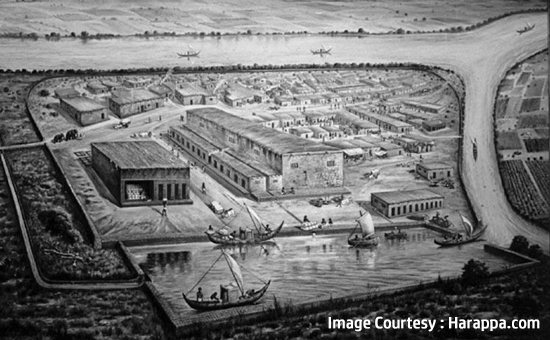 Harappa
Harappa
Another
city, Dholavira, in the Harappan civilisation was excavated in Gujarat in 1989,
and it was found that it existed before 3000 B.C. Channels and reservoirs here,
built of stone, prove that systems for water conservation in the city were a
civil engineering marvel. Rainwater as well as water from nearby streams was
stored in these structures.
A
few millennia later, Kautilya (B.C. 371-283) wrote in detail in Arthashastra how to manage village tanks. He had set rules for
the purpose. Ponds, tanks, etc., can be privately owned, and the owner is free
to sell or mortgage them (3-9- 33). The ownership shall lapse if the tank has
not been used for 5 years, except in cases of distress (3-9-32). Anyone who
accepts a waterworks as a pledge, with the right to use them, shall maintain
them in good condition (3-9-36). Owners may give water to others in return for
a share of the profit made by them through fields, parks or gardens (3-9-35).
In the absence of the owners, other individuals or the villagers as a whole
shall maintain the waterworks (3-10-3).
Varahamihira
of the 6th century (505-587 A.D.) has given detailed instructions on
construction of water reservoirs in Brihatsamhita. He wrote that without trees on their sides, lakes and ponds would not be strong or durable. He also listed trees most suitable for the
purpose, like Arjun, Vat, Aam, Peepal, Jamun, Ashok and the like (55-1).
Centuries
later, yet in olden times, many houses in Rajasthan had rooftop rainwater
harvesting systems. In a place near Pune, hundreds of cisterns, ponds and wells
were cut in rocks to store water. These are in use even today.
In
Burhanpur, Madhya Pradesh, Golkonda in Andhra Pradesh, Bijapur in Karnataka,
Aurangabad in Maharashtra, etc., underground earthen pipes used to carry water
to faraway places. In the Chandragiri Fort in Andhra Pradesh, built in the 10th
Century, trees around water reservoirs minimised loss due to evaporation, and lotus plants in the reservoirs and purified the water.
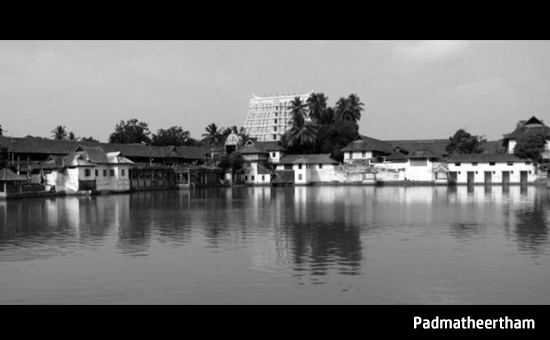 Padmatheertham temple tank, Kerala.
Padmatheertham temple tank, Kerala.
Padmatheertham
is the temple tank of Anantha Padmanabha Swami Temple, Thiruvananthapuram, the
earliest mention of which dates back to the 9th Century A.D. Many temples in
South India had, and still have tanks and wells of their own.
In
fact, thousands of water harvesting systems were present all over India in the
olden times, maintained by rulers and citizens alike. It is over the last 200
years that the country lost many of its traditional water harvesting sources.
In Delhi, for example, more than 270 step wells, built during the Mughal rule,
have dried up.
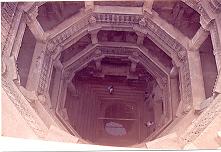 Adalaj-Vav Stepwell, Amdavad.
Adalaj-Vav Stepwell, Amdavad.
In
India, we have many water resources. Yet, the per capita availability of clean
water is decreasing day by day due to many factors like population explosion,
urbanisation, industrialisation, deforestation, overexploitation, siltation of
water bodies, neglection of traditional water conservation methods, drying of
wetlands, so on and so forth. Therefore, every effort must be made to conserve
this precious natural resource.
Rain
is the primary source of water. Forgetting this truth, we depend on secondary
sources like rivers, lakes and wells for our daily needs. This trend must be
reversed. Harvesting water was an Indian way of life in the distant past. We
must revive our traditional methods of water harvesting and also implement new
methods.
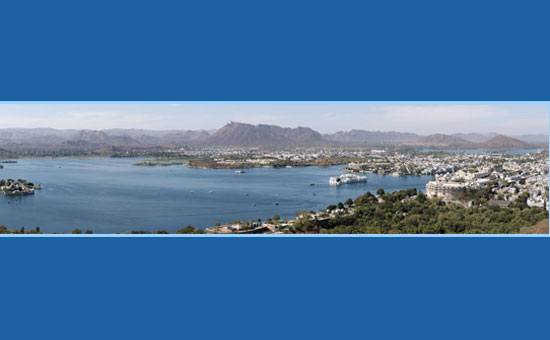 Lakes of Udaipur were made by the Maharanas, rulers.
Lakes of Udaipur were made by the Maharanas, rulers.
Rajendra Singh of Alwar district of Rajasthan understood this very well. He won the Magsaysay Award in 2001 and Stockholm Water Prize in 2015 for his water conservation activities. He bagged the title of ‘Waterman of India’ forhis inspirational efforts.
From
1984 onwards, Rajendra
Singh was responsible for the revival of about 3000 johads spread across more than 650 villages in Alwar district,
Rajasthan.
Johads are small earthen check dams that capture and conserve rainwater for dry seasons. It also improves percolation and recharges groundwater aquifers. He urged people to become ‘water literate’. He explained the meaning and concept of water literacy – understanding the importance of water, conserving it themselves, and motivating other people to save it.
Also read What
the water conservation effort in Alwar teaches us
About 500 years ago, Bengaluru had numerous beautiful water bodies, and became famous as ‘The city of lakes’. But, from 262 water bodies in 1960, the number has reduced to 81, of which only 34 are alive at present. However, it is heartening to see that young and old, like Anand Malligavad and B. Muthuraman respectively, are all set to rejuvenate some dying lakes. Their work has already started showing results.
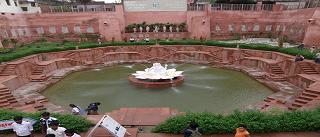 Kund at Vrindavan restored by the Braj Foundation.
Kund at Vrindavan restored by the Braj Foundation.
To
ensure conservation of water, religious norms and social duties were set down
by ancient Indian scriptures.
This is exactly what we mean by ‘community participation or ‘participatory management’ professed by today’s environmentalists. However, even when our government is trying to tackle the problem by various means like making rainwater harvesting mandatory, some people do not realise the seriousness of the issue. Dams are of course there, but the role of individuals is not less important.
Let
us dedicate ourselves to the cause of water conservation, and the time is not
far off when we will have enough of clean water for ourselves, and more to
spare, to be supplied to others.
To
read article in PDF format, click on
PDF.
Also
read
1.
Traditional
forms of water harvesting
2.
Album
Bundi Step-well
3.
Album Rani-ki-vav
Step-well Patan
4.
Album
Adalaj-Vav Step-well Amdavad
5.
About
Lakes of Udaipur
6.
Naul and Dhar Kumaon – A Cultural Heritage of the Himalayas
7.
The
Sacred Groves of Kerala
8.
Album Hampi
Water System
9.
Seven
Sacred Rivers
This article was first published in the Bhavan’s Journal, 15 January 2021 issue. This article is courtesy and copyright Bhavan’s Journal, Bharatiya Vidya Bhavan, Mumbai-400007. eSamskriti has obtained permission from Bhavan’s Journal to share. Do subscribe to the Bhavan’s Journal – it is very good.